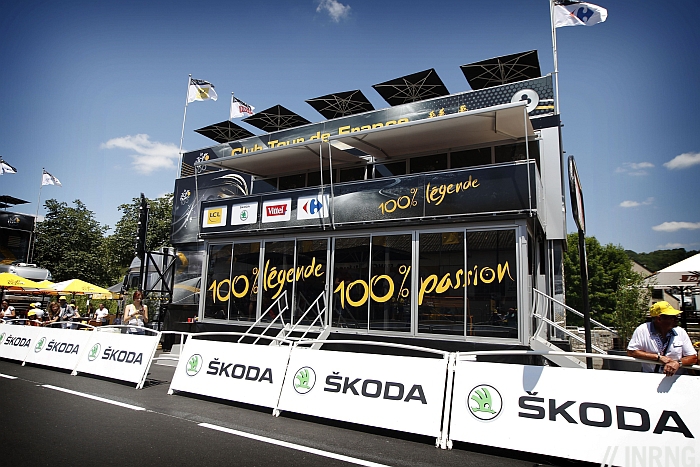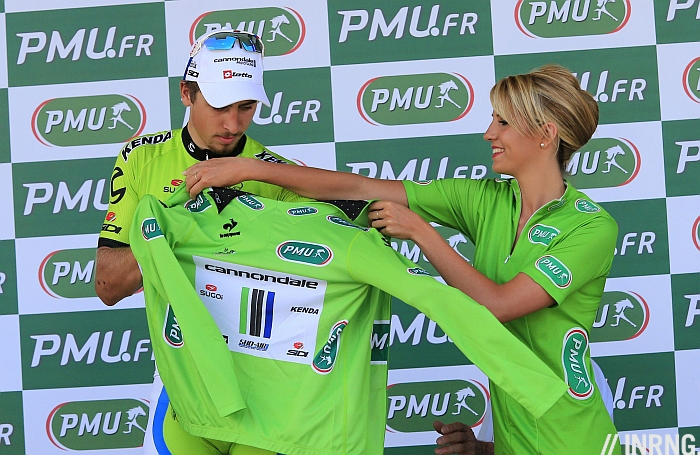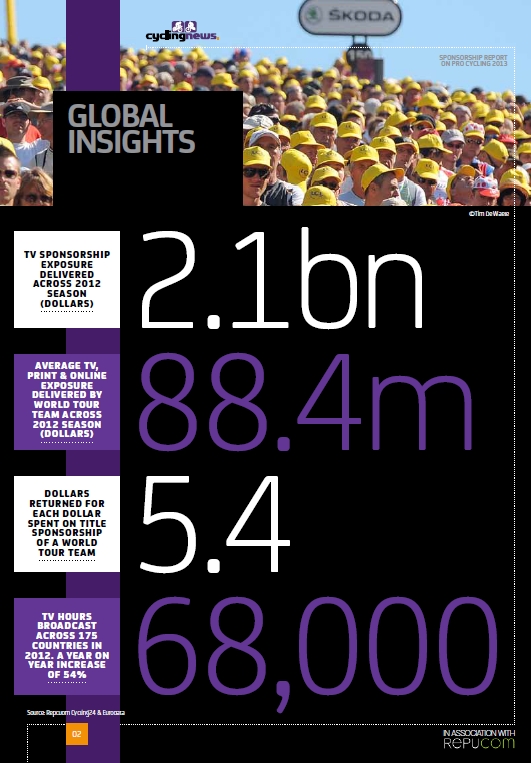Cycling represents great value for a sponsor. You’ve probably seen the news that a sponsor can get big publicity for a modest outlay, a big return for a small investment. What’s not to like?
But talk of return ignores the other side of the coin: the risk. Sponsor a pro team and it can blow up in your face with a doping scandal. Even if all your riders are healthy and honest then backing a team still isn’t for every brand.
But whilst several teams are struggling for sponsors, multinational corporates are backing the Tour de France, partnering with the event instead of its participants. Here’s a look at what it costs to get your company name on leader’s jersey and more.
Many pro cycling sponsors are firms you have not heard of. Follow the sport closely and you probably know what Belkin and BMC are about but firms like Lampre, Belisol, Argos or Quick Step can leave even keen cycling fans perplexed (answers here). The point to note is that the Tour is global sports event but few global brands consider pro team sponsorship.
Value
To sponsor a decent team in the Tour you need about €10 million a year. There are set-up costs for a new squad and budgets vary, get more co-sponsors and you can get more income. The rewards can be big, a study by Repucom and cyclingnews.com says for every dollar spent, $5.4 are returned in publicity.
Risk vs Return
But return has to be measured against risk. Do you have any savings? Because if you do some assets are offering a big return, for example Greek bonds offer 11% instead of the usual 2-4% return. Or you could stick the lot on Andy Schleck to Wednesday’s time trial stage in the Tour, that will return 300 times your “investment” should it happen. This shows the problem, sadly pro cycling has been seen as a high risk matter.
Image questions
Sports sponsorship is not for everyone. And each sport has a different demographic, attracting a particular audience with varied male/female splits, geographic locations, income and consumption habits.
As well as the risk-reward calculation there’s the numerical bias: you lose more often then you win. Even in the Tour de France where there are several prizes on offer, there are 22 teams chasing 21 stage wins and several teams will finish the race without much to speak of. You might get publicity on TV with the logo but this is not always valuable. A team might get airtime for going in a breakaway but al.l this TV can just link your brand to plucky losers.

Reputation worse than reality?
Backing a team needn’t mean a doping scandal. But if the board of a large company is considering sports sponsorship, cycling’s reputation could weigh more than the actual risk. A team that takes care to hire the right managers and riders can cut the risk substantially, just see Garmin-Sharp or FDJ but pick many more names. Even if a sponsor is not cycling-savvy google is enough to know you hire Danilo Di Luca at your peril. It was said Festina sold many watches in the aftermath of the eponymous doping scandal in 1998 but it’s a small brand that got notoriety. A big company won’t take chances with its brand.
The good news here is that if cycling can put the scandals in the past then sponsors will return, cycling becomes a safer bet and remains a great way to convey a message about team work. But for now risk-averse companies are reluctant to link their brands and cash with teams.
Cheap, safe, success: pick all three
What if there was a way to avoid doping scandals, associate with success, to get guaranteed publicity in the Tour de France and save money? It might sound too good to be true but the next time you watch the Tour de France, look around. You’ll see the yellow jersey sponsored by LCL, a bank, the green jersey by PMU, the French state betting company and apparently the world’s second biggest gaming company by some measures and the polka-dot jersey is sponsored by Carrefour, a supermarket. These are all big blue chip companies. In addition we see big multinationals like Nestlé and Volkswagen Group all over the race too with their brands like Vittel and Skoda respectively. These companies won’t back a team but will sponsor the race. Some names appear only in July but let’s salute Skoda, a big sponsor of events all year.

Just find €1.5 million
Sponsoring a jersey in the Tour de France is cheap. Just find €1.5 million and you could sign a deal for the green jersey, that’s what it costs in cash terms. In return you get a logo on the green jersey, a branded podium ceremony, the intermediate sprint decked out in the corporate ID and a ticket to ride in the publicity caravan that passes the race.
But if only sponsorship was as transactional as a cash payment and renting space on a jersey. Instead a sponsor on the Tour will spend up to a million Euros, perhaps more, on additional items during the three weeks. Based on an article in L’Equipe last year by Frédérique Galametz (paper edition, no link available), here is what PMU will bring:
- 200,000 green plastic hands
- 100,000 branded flags
- 50,000 replica green jerseys
- 45 staff on duty for three weeks
- 22 vehicles from dressed up publicity caravan items to three trucks to haul the gear
It’s not just plastic hands and polyester shirts, the Tour is a great moment for corporate VIP work, a chance to invite clients and management to experience something. Some teams are beginning to exploit this too, offering a seat in the team car to VIPs and guests.
Sponsoring the Tour is a good short cut. You don’t have to front up money for a team to ride an untelevised event in the middle of nowhere, instead you get the publicity of the biggest race of the year. But event sponsorship has its downsides. Mercifully there are no naming rights, we talk about the yellow jersey rather than the LCL jersey but this means reduced publicity.
Conclusion
Sponsoring a pro team brings rewards but risks too. Several teams are struggling to find funding for 2014, in the Tour alone there’s Euskaltel-Euskadi, Vacansoleil-DCM, Europcar and Sojasun. Meanwhile Orica-Greenedge, Belkin and Radioshack-Leopard (Trek next year) are riding in 2014 but searching for co-sponsors.
Meanwhile the Tour de France is packed with big corporate sponsors, giant multinationals delighted to spend millions. Nestlé is all over the race with brands like Powerbar, Nesquik and Vittel. Skoda is a massive sponsor of the sport as it supplies vehicles and cash to the Tour and many other races around the world. This allows them to cash in on the publicity bonanza of the race but without the risks.
If the sport can leave its reputation for risk in the past then there’s plenty to gain, companies will see the returns on offer. But for now there are too many squads worried about the future whilst the Tour’s profits grow.



200,000 green plastic hands, it seems more like 200,000 million of em.
To what extent do ASO pass on the funds raised through race sponsorship to the teams? Are there mechanisms besides prize money?
Teams get a cash payment too for expenses but it’s small. There are arguments for ASO to share its money with the teams… but ASO could charge money for teams to ride given its event is a giant publicity platform too. That topic though is for another day.
Powerbar is also a Nestle brand, and seems to be one of the most dominant logos I’ve seen in any podium photos this year.
…and if I kept reading, I would have seen that you already mentioned that.
PB is also responsible for the cheezy engraved glass trophy:
http://www.steephill.tv/2013/tour-de-france/photos/stage-09/#555-IMG_8406_edited-1.jpg
Sponsoring the event makes more sense than sponsoring the team. After all billions of people watch and attend the TdF but how many watch the other races ? Even the Giro and Vuelta have about 1/4 the audience as the TdF.
It’s tough to pull off a .1 event when there are few superstar riders and corporate sponsors hesitate to support teams or events where you might only attract 10,000 pair of eyeballs. Fans and tv audience combined.
It will be stunning to see the Euskatel name and what it represents disappear from the scene. It’s not just the pro team that goes. As in the case of Rabobank, Euskatel is also sponsoring development teams and youth racing programs. That money dries up as well.
What really is at heart is the fickleness of the fans. Hard core and casual. We want to see riders flying up huge cols and massive bunch sprints with riders going 70kph and crashing. We want to see parcourses with 5 huge cols and break-neck descents. But, when it is revealed to us that in order to bring us that level of entertainment or wow factor, the athletes have to dope to give us the show that we want. We and the coprporate sponsors take on an attitude of, “How dare they”. Or, ” I can’t follow a sport that is dirty and full of cheats”.
If you get rid of the cheating and doping, you get a sport that is dull and lifeless to the average fan. Shorter stages, fewer climbs, and many other ideas have been presented to present a more sane challenge to the rider. But, we as fans yawn and complain how lifeless the 2012 Tour was because it lacked a parcourse that sparked our imaginations.
When the fans get turned off, the sponsorship money dries up. Yet, we have the audacity to complain when the riders, team management, sponsors and race organizers do what they have to do to make us feel entertained.
No offence intended – but this is bollocks. The sport is not riveting because it needs superhuman performances or the stages are too long. Maybe this is a revelation but people dope for the 100 m. dash.
Unless you have a chronometer, you don’t know if the sprint is at 65 km/h or at 60. And unless you get a boner from doing TT speed splits, I don’t think anyone cares much if Cancellara goes at 48 or 51 km/h.
The problem with the 2012 Tour was not the course, was the dominance by Sky.Unless you were a fan, I’d argue the US Postal domination was very boring. At least from 2004 onward, when many of us knew the drill “take the first mountain stage by storm, assemble the train, consolidate in the TTs, strangle the race”.
Take a look at some of the shorter stages in recent races – they have been much more animated than some much longer ones. Most of cycling fans I know don’t “pay by the km”, or minute.
To the casual fan, they are looking for the bling and eye – popping performances. Much like American baseball. The old axiom, “Chicks dig the long ball” certainly applied during the steroid era. Now that steroid use is down or at least minimized, there are no eye-popping performances and casual interest is down.
As to the racing aspect, Last years course was designed to be plodding and calculating for power riders and their teams. Only Sky could adapt to a par course suited to USPS. Pretty boring racing. This years parcourse makes it difficult for one tea to control the pace.
Yes, the casual fan wants excitement, eye candy (the much discussed podium girls), and super human performances. My point was, cycling was trying to provide that through the use of PED’s. For our entertainment. Many friends tell me cycling is boring. I tell them it is a lot like golf and baseball. Once you know how the sport works it is more entertaining. The casual fan doesn’t care about strategy. They want to see guys like Pantani and LA entertain us with their charisma and athletic prowess. Then when they got discovered, we the fans acted as if we were mortified.
Well that’s fairly arrogant (and sexist probably – although I have no idea what “Chicks dig the long ball” means). What makes you think that casual fans want these things? Clearly they are not in your intellectual class but perhaps they are capable of undertanding the strategy and tactics, the teamwork and the pain. You really need to take a look at yourself.
It means, girls (and most casual fans) like to see baseball players hit home runs (the long ball). It’s a common saying here in America. Watching a baseball team work to score a run is not entertaining. Much like with cycling to the casual viewer.
Outside of the TdF most Americans do not realize that cycling exists. Many think it is a one time event. So, when they do turn it on, they want to see excitement or someone like LA dominating the event.
I say get rid of team radios, power meters and heart monitors that should spice up the racing, bring some randomness, unpredictability and art back to the racing. It might mean some breakaways stay away, it might mean riders judge and misjudge their effort and we might witness spectacular escapes and spectacular meltdowns on the cols. Watching riders sticking to the numbers can inanimate the racing, which resort to stranglehold tactics that can close down the variety of opportunity.
Not to forget track racing is some of the most exciting and only has distance of <1km
I want to know what that hand is doing in the main picture, and has it lost a pint of lager along the way?
That’s the hand Peter uses for his hanky-panky !
Mr Hinault making sure that Sagan keeps his hand off the pretty French girl.
You have to laugh at the idea that cycling is so dirty, not even Dutch bankers- the rich lepers of our age- want to be associated with a team. Still Ulrike Greenwich is getting a lot of mentions from Sean Kelly this year. Who does she ride for?
An Post, obviously.
Inring, what is the estimate of the total economic impact of the tour? And how does that compare with
say 20 days of the World Cup?
Well last night’s breakaway was certainly a plea for 2014 sponsorship! Euskatel, Europcar, Vacansoleil and Sojasun. Plus the previously invisible Cofidis.
Was thinking the same thing earlier. Glad cofidis is now able to share 3100 euros and not 1600 until today.
Personally I think sponsoring a team is a better investment than sponsoring a jersey. I’m not a huge cycling fan but from just watching the tour I can reel off the names of most of the teams, (though admittedly Sojasun had passed me by until yesterday! On the other hand I’ve never really noticed who is sponsoring the jerseys or even that they are sponsored.
Even those sponsors who are involved with the races themselves are not risk free in my view. Association with the sport can be damaging as direct association with a ‘dirty’ team. Remember that in the scandals of a few years ago, it was the reputation of the Tour itself that was most damaged.
Ask people in the street if they remember the drug scandals of the Tour de France and other than Lance Armstrong, I doubt they could name a single rider. To the general public, the Tour IS cycling and any harm to its reputation reflects badly on the sport entire.
During today’s coverage (TT on 07/10) one of the P’s said that TREK had bought the team license from Radio Shack, is that accurate? So we’ll have BMC, Cannondale and Trek with trade teams at the top level. Perhaps the industry has grown large enough to support this kind of investment now, or perhaps this is a necessary step until marketers outside of cycling regain a comfort level with cycling and potential PR issues?
Yes it’s true. Trek will sponsor the team in 2014 but are looking for co-sponsors.
Doping is simply the perfect excuse for companies wanting to move out of cycling, whenever it is decided that it’s “over” and it’s time to move on for any reason (to another sport, area, public, demographic, etc.). Although being associated with something good and positive is desirable, as long as there’s audience, big corporations don’t care much for associations or image. Why took Nike & Co. so long to drop Armstrong?
Small events/teams with positive values and work ethic will have a much harder time finding sponsors than, say, big events with not-as-good reputation but which still draw millions and get big coverage (pref. TV time). That’s basic marketing, for no other reason FIFA and soccer in general, being as corrupt and scandal-riddled as it is, have no problem with money and sponsoring. You don’t get bigger than the World Cup, any scandal just pale and get buried in the face of its enormity, diversity and variety.
And it’s like that because, except for those living in a cave for the last 50 years, the realization that every sport is (at the very least) as corrupt, drug-fueled and dirt as cycling is basic knowledge. There’s simply no way to be big and clean. So the impact for these companies may not be as what we cycling fans immagine. We – fans, journalists, riders, etc. – make a bigger deal out of it ourselves. Top athletes get busted all the time in all sports, some structures are just more efficient (and/or rich) to cover and/or minimize the impact.
Pat and Hein were well aware of that, so it should be no surprise as to what model they were following in trying to cover all the dirt…